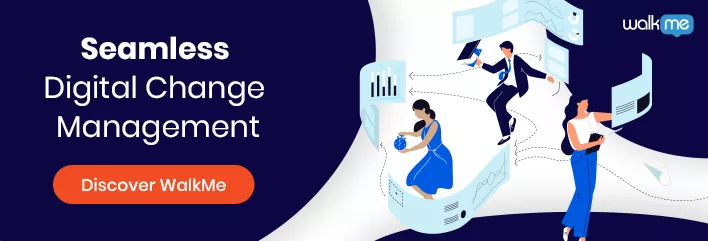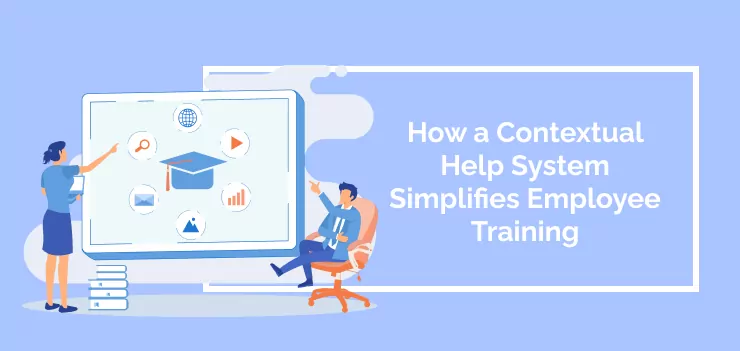
Training is essential to organizational change, and Contextual Help Systems solve common problems.
Imagine you’ve invested money in a fantastic new piece of software. It does everything you need, is reliable, and could improve your business in many ways. There’s just one challenge. Only a few people in your company know how to use it.
So how do your staff learn to use this new piece of software?
You could organize some mandatory training sessions. If the software is important, you could even ask for an examination! But usually, such solutions will take staff away from their work. And the training won’t even be relevant for some specialized applications.
In many cases, staff benefits most from instruction within the application – at the specific moments they need it. This method is called a contextual help system. These systems give support where staff needs it the most. And more importantly, those systems help to train staff quickly, efficiently, and effectively.
This article will introduce contextual help systems. We will begin by explaining how these systems work and how they help organizations to train their staff, especially during Change Management projects.
Then, we’ll look at digital adoption platforms, a package that takes embedded help even further.
Read on to find out how.
What Is a Contextual Help System?
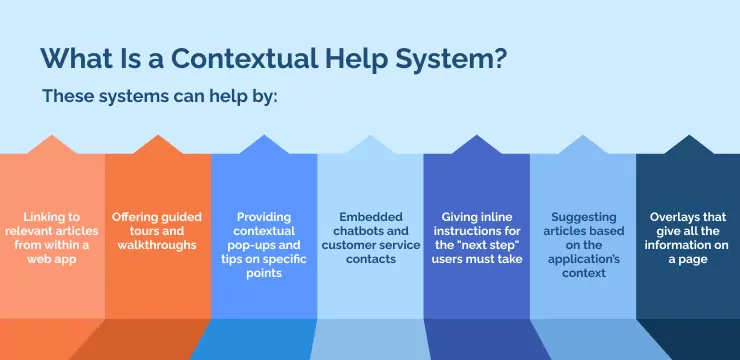
Software applications use a contextual help system when users get help in the specific context they need. Once upon a time, software packages came with a big user manual. By 1997, Microsoft brought out their radical Office Assistant, giving support when they needed it.
Now, contextual help is much more familiar. Whenever users meet a problem, they do not need to move to a different source: they get the answers they need right there. Other names for the same approach include “context-sensitive help” and “in-app support.”
These systems can help by:
- Linking to relevant articles from within a web app
- Offering guided tours and walkthroughs
- Providing contextual pop-ups and tips on specific points
- Embedded chatbots and customer service contacts
- Giving inline instructions for the “next step” users must take (for example, to complete a form).
- Suggesting articles based on the application’s context
- Overlays that give all the information on a page.
These systems all help staff to complete their work quickly and confidently. Users don’t open a paper manual, ring a help desk, or even go to a different website when they meet a challenge. And they don’t need to ask everyone in the office for help! They can just carry on with their workflow and get the job done.
In the bigger picture, contextual help systems support digital adoption. In other words, contextual help ensures that every company gets the most out of its digital implementation projects. (We will come back to this soon)
The Benefits of Contextual Help Systems for Staff Training
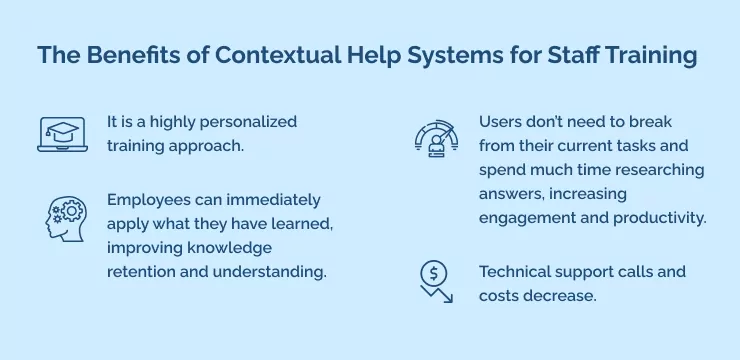
Effective training is crucial to get the most value from new software.
However, many traditional training methods are ineffective for modern software applications. For example, facilitator-led training is costly and cannot be scaled effectively. Mentorship, tutoring, and on-the-job group training all have the same problems.
Contextual help systems are a great alternative to traditional forms of training. It is a form of contextual training that benefits users and businesses. For example:
- It is a highly personalized training approach.
- Employees can immediately apply what they have learned, improving knowledge retention and understanding.
- Users don’t need to break from their current tasks and spend much time researching answers, increasing engagement and productivity.
- Technical support calls and costs decrease.
In 2018, a McKinsey report suggested that self-serve technology was key to digital transformation success. This holds true today. When staff has easy access to everything they need, they are likelier to succeed.
How Digital Adoption Platforms (DAPs) take Context-Sensitive Help to the Next Level
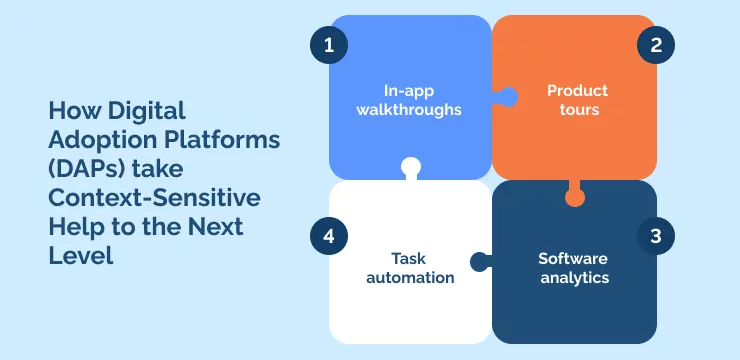
Digital adoption platforms (DAPs) are training solutions that offer contextual training. However, they take this training approach even further than contextual help systems.
DAPs aren’t just trying to give a quick fix to regular problems. They are built around a philosophy of digital adoption. The aim of “digital adoption” is to make sure that everyone uses a piece of software – and that they all use it correctly. Digital adoption is the end goal of digital implementation projects.
DAPs offers a slightly different portfolio of options compared to contextual help systems. Those options include:
- In-app walkthroughs. Using pop-up bubbles, an interactive walkthrough takes users one step at a time through a series of actions. Like contextualized help systems, they operate inside the context of the software itself. However, they can train users on a complete workflow.

- Product tours. A product tour is an interactive introduction to a product’s features and functions. These tours can be used on a website, in a software trial, after sign-up – or at all of these points in the user journey – to streamline onboarding and improve competency.

- Software analytics. Analytics can track user behavior throughout the onboarding and training experience, monitoring interactions with software. That information, in turn, can be used to further improve training walkthroughs and product tours.

- Task automation. Certain digital adoption platforms can also automate repetitive tasks. This frees up employee time for more valuable activities, reducing error rates and massively increasing productivity.
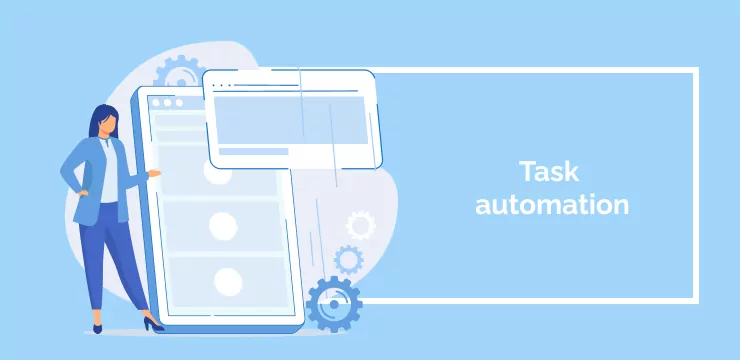
All of these features can dramatically improve the training process. Instead of countless calls to a support team, new users get all the resources they need with minimal disruption to their work.
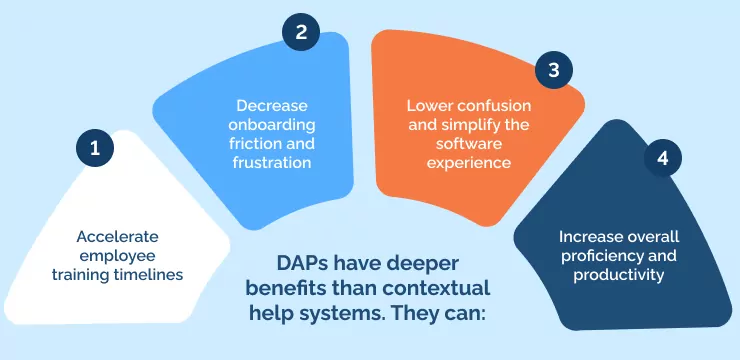
DAPs have deeper benefits than contextual help systems. They can:
- Accelerate employee training timelines
- Decrease onboarding friction and frustration
- Lower confusion and simplify the software experience
- Increase overall proficiency and productivity.
How Contextual Help and DAPs drive Digital Adoption
Digital adoption means using technology for its intended purpose and to its fullest extent. Contextual help and DAPS both help support this.
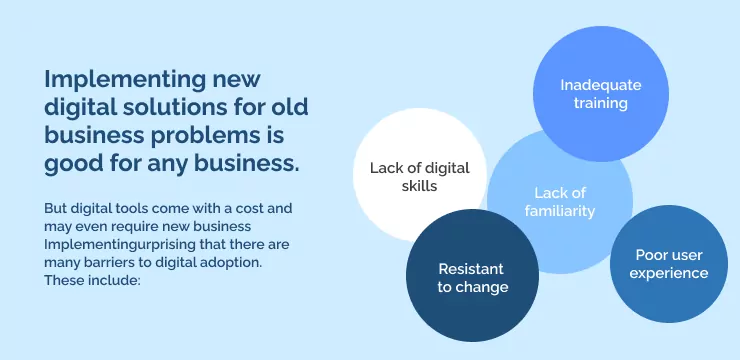
Implementing new digital solutions for old business problems is good for any business. But digital tools come with a cost and may even require new business Implementingurprising that there are many barriers to digital adoption.
These include:
- Lack of digital skills
- Resistant to change
- Lack of familiarity
- Inadequate training
- Poor user experience.
Self-service solutions lead businesses to the deep changes they need to assist users.
Both contextual help and digital adoption platforms reduce these barriers. By providing targeted and personalized support at key points in the digital adoption process, these tools can help users feel more comfortable and competent using digital tools.
These tools are highly scalable, intuitive, and flexible.
Contextual Help Systems: The Future of Work

Contextual help and DAP systems are the training system of the future. With more detail than a help center and embedded directly into the working environment, they can seamlessly lead staff through their workflows. Instead of expensive training and arcane support documentation, users can just get on with their work.
Traditional training approaches suffer from several problems in the modern work environment, making them unsuitable for the digital workplace. Employee training, therefore, must focus not only on training employees but also on maximizing software value and streamlining the digital workplace.
WalkMe Team
WalkMe spearheaded the Digital Adoption Platform (DAP) for associations to use the maximum capacity of their advanced resources. Utilizing man-made consciousness, AI, and context-oriented direction, WalkMe adds a powerful UI layer to raise the computerized proficiency, everything being equal.



